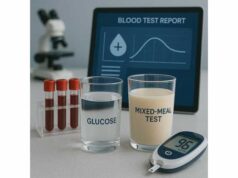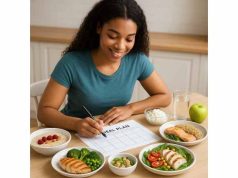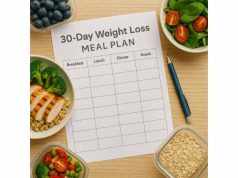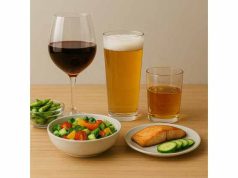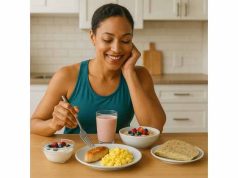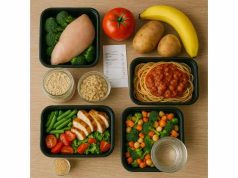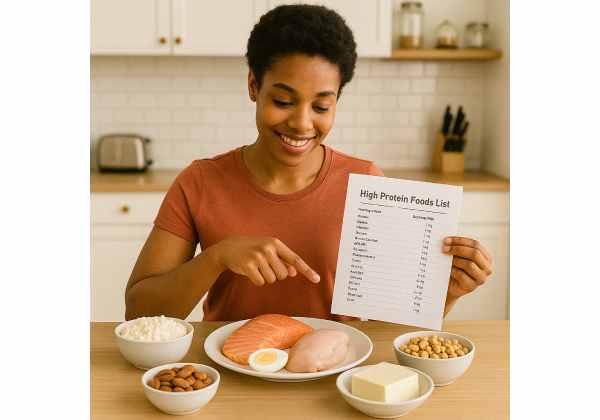
Protein is the quiet lever that makes fat loss easier. It calms hunger, protects muscle while you diet, and keeps meals satisfying even as calories come down. The challenge is not “eat more protein” but which foods, how much, and how to build meals you can repeat on busy days. Below you will find a clear, practical list of high-protein foods with real-world serving sizes, plus templates for breakfast, lunch, dinner, and snacks. If you still need to set daily calories and macro targets, start with our concise primer on calorie budgeting and meal planning, then return here to stock your kitchen with the right staples.
Table of Contents
- What counts as high-protein?
- How many grams per day?
- Animal proteins with servings
- Plant proteins with servings
- Budget and convenience picks
- Build high-protein meals
- Safety, digestion and quality
- Frequently Asked Questions
What counts as high-protein?
“High-protein” is not a fad label; it is a useful threshold that helps you choose foods that deliver plenty of protein per serving and per calorie. For weight loss, the best choices do three things at once:
- Provide at least ~15–25 grams per typical serving (breakfast foods can be a touch lower if you combine items).
- Offer good protein density—you get a lot of protein for the calories spent.
- Are easy to cook, pack, or reheat so you can hit your number on ordinary days.
Why protein helps fat loss
- Satiety: protein is the most filling macronutrient. A protein-anchored meal reduces cravings and late-night nibbling.
- Muscle retention: in a calorie deficit, adequate protein helps protect lean mass, which supports a higher daily energy burn and better shape change.
- Thermic effect: digesting protein costs more energy (roughly 20–30% of its calories) compared with carbs or fat. That is not magic, but it is a quiet advantage.
How to scan a label or menu quickly
- Per serving grams: look for 15–30 g per single food item (yogurt cup, cottage cheese bowl, 3–5 oz cooked meat or fish, 150–200 g tofu/tempeh).
- Per 100 calories: if a food delivers around 18–25 g protein per 200 calories, it is usually a strong choice.
- Added sugars and fats: flavored yogurts, breaded meats, creamy sauces, and “keto” snacks can dilute protein density. Plain or lightly seasoned versions are usually better.
Categorizing high-protein foods
- Lean animal proteins: chicken and turkey breast, 90–96% lean beef, pork tenderloin, white fish, tuna, shrimp, egg whites, low-fat cottage cheese, and Greek yogurt.
- High-protein plant foods: tofu, tempeh, seitan, edamame, soy milk, and legumes (lentils, beans, chickpeas).
- Protein supplements (optional): whey, casein, soy, or pea blends—useful to fill gaps, not mandatory.
What about fatty cuts and cheese?
They can fit, but calories climb quickly. Use measured portions and surround them with high-volume vegetables so the plate still looks generous.
Context matters
Protein does the heavy lifting, but you still need vegetables, some carbs, and measured fats for energy, fiber, and micronutrients. For a broader foundation (movement, sleep, and habit systems), skim our practical guide to safe, sustainable weight loss.
How many grams per day?
There is no single perfect number, but there is a practical range that works for most adults who want to lose fat while protecting muscle: 1.6–2.2 g of protein per kilogram of body weight (about 0.7–1.0 g per pound). If you carry a higher body-fat percentage, set protein based on goal weight or an estimate of lean mass to avoid overshooting.
Quick targets by body weight
- 60 kg (132 lb): 95–130 g/day
- 75 kg (165 lb): 120–165 g/day
- 90 kg (198 lb): 145–200 g/day
Per-meal targets (the simple rule)
Aim for 25–45 g protein at each main meal, depending on your size and appetite. Hitting this “floor” supports satiety and muscle protein synthesis. Many people do well on three meals of 30–40 g plus an optional 20–30 g snack.
What about training days?
You do not need a completely different target, but getting protein soon after tough sessions is smart. Carbs around workouts support performance; protein covers recovery.
A fast way to check your day
- Breakfast: Greek yogurt with berries and chia (25–30 g).
- Lunch: chicken or tofu salad bowl (30–40 g).
- Dinner: salmon with vegetables and potatoes (30–40 g).
- Snack (optional): cottage cheese or a shake (20–25 g).
If you want a deeper dive into setting grams by body weight and goals, use our straightforward calculator and ranges here: daily protein targets.
Hitting the number without counting forever
- Anchor meals with a clear protein source.
- Keep ready-to-eat options on hand (tuna pouches, cooked chicken, tofu cubes, yogurt, cottage cheese).
- Use templates (see the “Build high-protein meals” section) so you can assemble food quickly on stressful days.
Common concerns
- Kidneys: in healthy people, higher-protein diets are generally safe; if you have kidney disease or risk factors, ask your clinician for a personalized limit.
- Constipation: raise fluid and fiber (vegetables, fruit, legumes); add a daily walk.
Animal proteins with servings
Below are realistic portion sizes and approximate protein amounts for cooked foods (unless noted). Values vary by brand and preparation; treat them as useful ranges, not lab readings.
Poultry
- Chicken breast, skinless: 3 oz (85 g) ≈ 26 g; 5 oz (140 g) ≈ 44 g.
- Turkey breast, skinless: 3 oz (85 g) ≈ 26 g; deli turkey, 4 oz (115 g) ≈ 20–24 g.
- Ground turkey 93% lean: 4 oz cooked (113 g) ≈ 25–28 g.
Beef and pork (lean cuts)
- Lean ground beef 93–96%: 4 oz cooked (113 g) ≈ 24–27 g.
- Top sirloin or eye of round: 3 oz (85 g) ≈ 22–25 g.
- Pork tenderloin: 3 oz (85 g) ≈ 22–24 g.
Fish and seafood
- Salmon (Atlantic or coho): 3 oz (85 g) ≈ 20–22 g; 6 oz (170 g) ≈ 40–44 g.
- Tuna (canned in water): 1 can (5 oz/140 g drained) ≈ 24–27 g.
- Cod, haddock, tilapia: 3 oz (85 g) ≈ 18–20 g.
- Shrimp: 3 oz (85 g) ≈ 18–20 g; 6 oz (170 g) ≈ 36–40 g.
Eggs and dairy
- Eggs, whole: 1 large ≈ 6–7 g; 2 eggs ≈ 12–14 g; 3 eggs ≈ 18–21 g.
- Egg whites: 3 whites ≈ 10–11 g; 5 whites ≈ 17–18 g.
- Greek yogurt, plain 2%: 170 g (about ¾ cup) ≈ 17–20 g; 200 g ≈ 20–23 g.
- Cottage cheese, low-fat: 1 cup (226 g) ≈ 24–28 g.
- Milk, dairy: 1 cup (240 ml) ≈ 8 g (higher-protein filtered milks provide more per cup).
High-protein deli and convenience picks
- Rotisserie chicken breast (skin removed): 4 oz (113 g) ≈ 26–28 g.
- Turkey jerky or biltong: check labels; often 9–12 g per 1 oz (28 g).
- Tuna or salmon pouches: 2.6–3 oz (74–85 g) ≈ 16–20 g.
How to use these in meals
- Breakfast: eggs plus cottage cheese or Greek yogurt to hit 25–35 g quickly. For more morning ideas, browse our concise high-protein breakfast picks.
- Lunch: 4–6 oz (113–170 g) chicken or salmon over a large salad with a spoonful of olive oil and vinegar.
- Dinner: 5–6 oz lean meat or fish with two big vegetable sides and a measured carb (e.g., potatoes or rice).
Flavor with minimal calories
- Spice rubs, citrus, vinegar, mustard, salsa, yogurt-herb sauces, capers, pickles.
- Grill, roast, air-fry, or poach. Breaded/fried versions add calories quickly and can halve protein density.
Batch-cook trick
Cook 1–1.5 kg of chicken breast or turkey once per week. Portion in 120–150 g bags. You will never “miss” your protein floor on busy days.
Plant proteins with servings
Plants can absolutely cover high-protein needs—especially soy foods, seitan, and legumes. You may need slightly larger portions or smart combinations to reach 25–45 g per meal, but the result is filling, fiber-rich plates that support weight loss.
Soy foods
- Tofu (firm): 150 g ≈ 18–22 g; 200 g ≈ 24–28 g.
- Tempeh: 100 g ≈ 17–20 g; 150 g ≈ 25–30 g.
- Edamame (shelled): 1 cup (155 g) ≈ 17 g.
- Soy milk (unsweetened): 1 cup (240 ml) ≈ 7–9 g.
Gluten-based
- Seitan: 3 oz (85 g) ≈ 20–22 g; 100 g ≈ 25 g. (Skip if you need gluten-free.)
Legumes (cooked)
- Lentils: 1 cup (198 g) ≈ 18 g; ½ cup ≈ 9 g.
- Black beans: 1 cup (172 g) ≈ 15 g; ½ cup ≈ 7–8 g.
- Chickpeas: 1 cup (164 g) ≈ 14–15 g; ½ cup ≈ 7–8 g.
- Peas: 1 cup (160 g) ≈ 8 g.
Plant-based yogurts and alternatives
- Protein varies widely. Choose soy or pea-based options with 10–20 g per serving and minimal added sugars.
Protein powders (optional but handy)
- Soy or pea blends: typically 20–25 g per scoop; mix with soy milk for an easy 30+ g snack or breakfast base.
Build complete meals
- Tofu stir-fry: 200 g tofu (24–28 g) + 300–400 g vegetables + small portion of rice.
- Lentil bowl: 1 cup lentils (18 g) + 150 g mixed vegetables + ½ cup (125 g) Greek-style soy yogurt (10–15 g) on top.
- Seitan fajitas: 120 g seitan (30 g) + peppers and onions + 2 small corn tortillas.
Digestibility and comfort
- Soak and rinse canned beans; start with ½ cup portions and increase over 2–3 weeks.
- Add herbs (cumin, fennel), vinegar, or citrus to legume dishes; they often feel lighter.
- Rotate soy, legumes, and gluten (if tolerated) to diversify amino acids, fiber types, and flavors.
For a ready-made, plant-forward week that hits protein targets, skim our simple vegan high-protein meal plan—then mix and match with your favorites.
Budget and convenience picks
High-protein does not have to mean high cost or long prep. The trick is to buy protein workhorses and pair them with low-cost, high-volume staples.
Low-cost protein staples
- Eggs and egg whites: versatile and inexpensive.
- Canned tuna, salmon, sardines: shelf-stable, 16–27 g per single-serve pouch/can.
- Chicken thighs and drumsticks: slightly fattier than breast but affordable; remove skin and bake or air-fry.
- Dried lentils and beans: pennies per serving; batch-cook and freeze.
- Tofu and tempeh: often cheaper than meat per gram of protein.
- Cottage cheese and plain Greek yogurt (tubs): lower price per gram than single-serves.
High-volume sides that stretch meals
- Potatoes, carrots, onions, cabbage, frozen mixed vegetables, oats, rice, barley.
- Seasonal fruit; frozen berries for smoothies and yogurt bowls.
Meal-prep that actually fits a weekend
- Roast two sheet pans: one with protein (chicken thighs/tofu) and one with vegetables (broccoli, peppers, onions).
- Cook a pot of lentils or beans and a pot of potatoes or rice.
- Portion cooked protein in 120–150 g bags and freeze half.
- Keep tuna pouches and a tub of yogurt or cottage cheese for no-cook days.
Fast assemblies under 10 minutes
- Yogurt bowl: 200 g Greek yogurt + berries + chia (25–30 g).
- Tuna plate: 1 pouch tuna + pickles + tomatoes + 2 corn tortillas (20–25 g).
- Tofu scramble: 200 g tofu + frozen peppers/onions + spice blend (24–28 g).
- Egg wrap: 2 eggs + thin wrap + spinach + hot sauce (18–22 g).
Restaurant and takeout strategies
- Choose grill or bowl formats: chicken, steak, shrimp, tofu with vegetables and a measured carb.
- Ask for sauces on the side; use teaspoons.
- Add a side of cottage cheese or yogurt at supermarkets for a quick protein bump.
If you want a full week under a modest grocery budget, our practical template is here: eat well on \$50–\$70 per week.
Build high-protein meals
Think of each plate as a kit: a protein anchor, a big pile of vegetables or fruit, a measured carb if you want one, and a small amount of flavorful fat. Hit your protein floor first; the rest can flex with appetite and activity.
Breakfast templates (aim 25–35 g)
- Greek yogurt bowl: 200 g yogurt (20–23 g) + 1 cup berries + 1 tbsp chia (2–3 g) + a spoon of high-fiber cereal (2–4 g).
- Eggs two ways: 2 eggs (12–14 g) + 3 egg whites (10–11 g) + sautéed mushrooms and spinach; optional thin toast.
- Protein oatmeal: ½ cup dry oats cooked, then stir in a scoop of whey/soy (20–25 g) and top with fruit.
Lunch templates (aim 30–40 g)
- Big salad bowl: romaine, cucumbers, tomatoes + 150 g chicken or tofu (28–35 g) + ½ cup beans (7–9 g) + 2 tsp olive oil and vinegar.
- Soup and wrap: broth-based vegetable soup + turkey or seitan wrap (25–35 g).
- Potato plate: two small boiled potatoes + tuna with yogurt-dill + side salad (25–35 g).
Dinner templates (aim 30–45 g)
- Stir-fry: 200 g shrimp or tofu (24–40 g) + 300–400 g mixed vegetables + 1–2 tsp sesame oil + soy-ginger sauce; optional small scoop of rice.
- Sheet-pan: chicken breast or tempeh + broccoli and peppers + spice rub; finish with lemon.
- “Pasta” feel: turkey or lentil meat sauce over zucchini ribbons; parmesan curls (measure).
Snack ideas (20–30 g, 100–250 calories)
- Cottage cheese (1 cup ≈ 24–28 g) with fruit.
- Protein shake with ice and cinnamon (20–25 g).
- Tuna pouch with crackers and pickles (16–20 g; add a yogurt to hit your target).
- For more bite-size options, see our quick list of 100–250 calorie snacks.
Flavor builders that cost few calories
Salsa, mustard, hot sauce, citrus, fresh herbs, spice blends, pickled onions, yogurt-herb sauces, reduced-sodium soy, vinegar. These make lean proteins feel like “real food” without blowing your budget.
Weekly rhythm that works
- Two breakfasts you like, alternating.
- Three lunches you can assemble anywhere.
- Four dinners on rotation, one higher-effort dish on weekends.
Keep it boring-in-a-good-way during the week; save novelty for one meal when you have time and attention.
Safety, digestion and quality
A higher-protein diet is appropriate for most healthy adults, but context matters.
Who should get medical guidance first
- Chronic kidney disease or reduced kidney function.
- Liver disease or history of gout.
- Pregnancy or breastfeeding (protein needs change; overall energy and nutrient balance matter).
- History of eating disorders—focus on flexible structure with professional support.
Digestion and comfort tips
- Increase protein and fiber gradually over 2–3 weeks; drink water.
- Rotate sources: poultry, fish, dairy, tofu, tempeh, legumes, seitan (if tolerated). Variety improves comfort and micronutrient coverage.
- If red meat causes reflux or heaviness, shift toward fish, poultry, and soy more often.
- For legumes, start with canned, well-rinsed beans or red lentils (softer), and add herbs like cumin or fennel.
Protein quality, briefly
Animal proteins are typically “complete” (contain all essential amino acids). Many plant proteins are lower in one or two amino acids but perform well when you eat enough total protein and vary sources (e.g., soy + legumes + grains). Hitting 25–45 g per meal with mixed sources is a practical way to cover your bases.
Sustainability and ethics
Choose seafood from responsible fisheries, leaner cuts of meat more often, and plant proteins frequently—for your health, budget, and the environment. Frozen options reduce waste and keep protein available when life gets busy.
Bottom line
Set a daily protein target you can actually hit, keep ready-to-eat options on hand, and build meals with protein first, produce next. The scale and your appetite will both respond.
Frequently Asked Questions
What is a good daily protein goal for weight loss?
Most adults do well with 1.6–2.2 grams per kilogram of body weight (about 0.7–1.0 g per pound). Split that across meals in 25–45 g portions to improve satiety and protect muscle. Set a simple floor you can hit on busy days and adjust by results.
Are protein powders necessary?
No. Food can cover your needs. Powders are convenient when appetite is low, time is short, or you are traveling. Choose whey, casein, soy, or pea blends with 20–25 g per scoop and minimal added sugars, and use them to fill gaps, not replace meals.
What are the best high-protein breakfast options?
Greek yogurt bowls, omelets or scrambles with egg whites, cottage cheese with fruit, and protein oatmeal are reliable. Aim for 25–35 g protein at breakfast so hunger stays calm and you do not “borrow” calories later from snacks or dinner.
Can I get enough protein on a vegetarian or vegan diet?
Yes. Center meals on tofu, tempeh, seitan (if not gluten-free), edamame, soy milk, and legumes. You may use a soy or pea protein shake to make breakfast or snacks easier. Mix sources and aim for 25–45 g per meal to cover amino acid needs.
Will more protein hurt my kidneys?
Higher-protein diets are generally safe for healthy adults. If you have kidney disease or risk factors, talk with your clinician for a personalized limit. Hydration and a gradual increase in intake improve comfort as you change your routine.
How do I hit protein when eating out?
Pick grill or bowl formats: chicken, steak, shrimp, or tofu with vegetables. Ask for sauces on the side, add a side of cottage cheese or yogurt when available, and consider a protein snack before or after the meal if portions are light.
References
- International society of sports nutrition position stand: nutritional concerns of the female athlete 2023 (Position Stand)
- Systematic review and meta‐analysis of protein intake to support muscle mass and function in healthy adults 2022 (Systematic Review & Meta-Analysis)
- Effects of Varying Protein Amounts and Types on Diet-Induced Thermogenesis: A Systematic Review and Meta-Analysis 2024 (Systematic Review & Meta-Analysis)
- Plant Proteins: Assessing Their Nutritional Quality and Effects on Health and Physical Function 2020 (Review)
Disclaimer
This article provides general information for adults and does not replace personalized medical advice, diagnosis, or treatment. Speak with your healthcare professional before changing your diet—especially if you have kidney or liver disease, diabetes, gout, are pregnant or breastfeeding, or have a history of disordered eating.
Share and follow
If this guide helped you stock a high-protein kitchen, please share it with someone starting a fat-loss plan. For new, practical articles and templates, follow us on the social platform you use most—Facebook, X, or another network you prefer.

